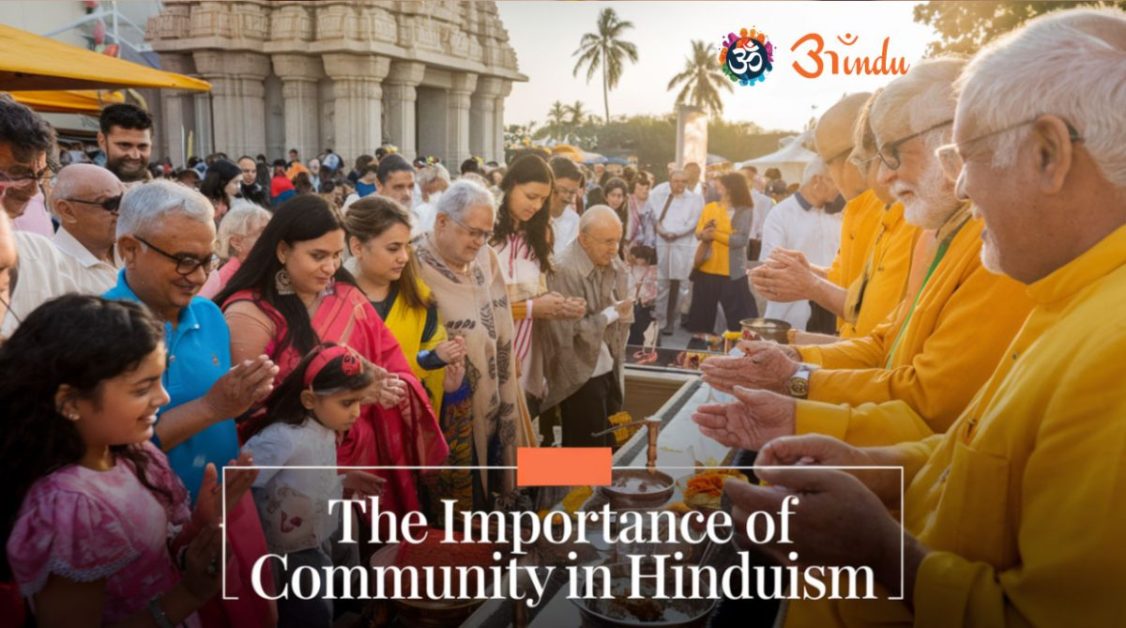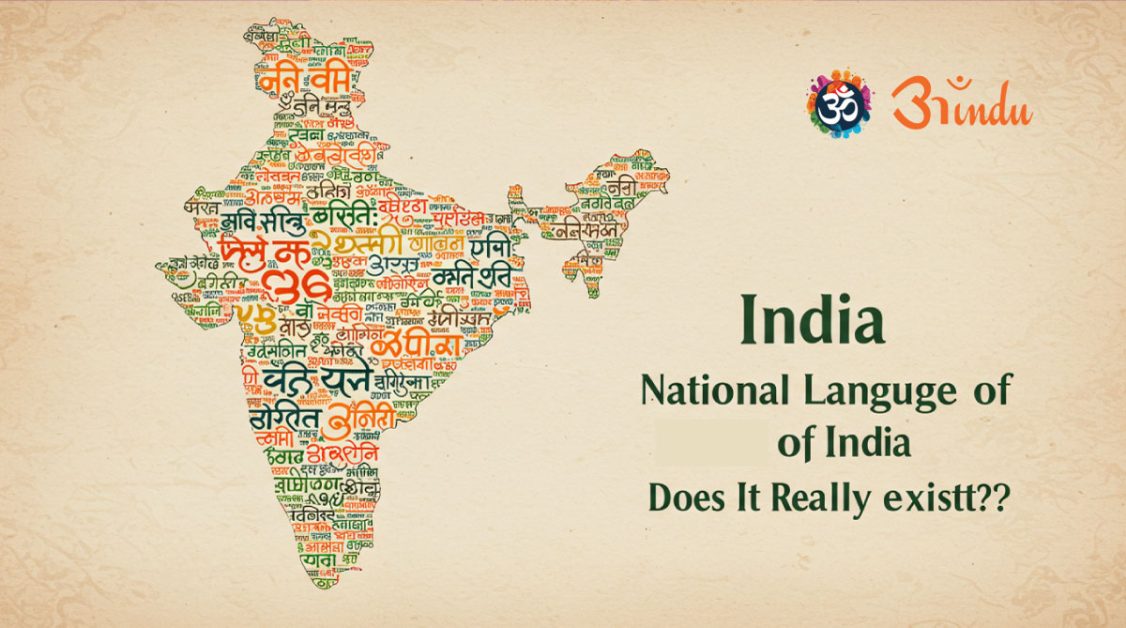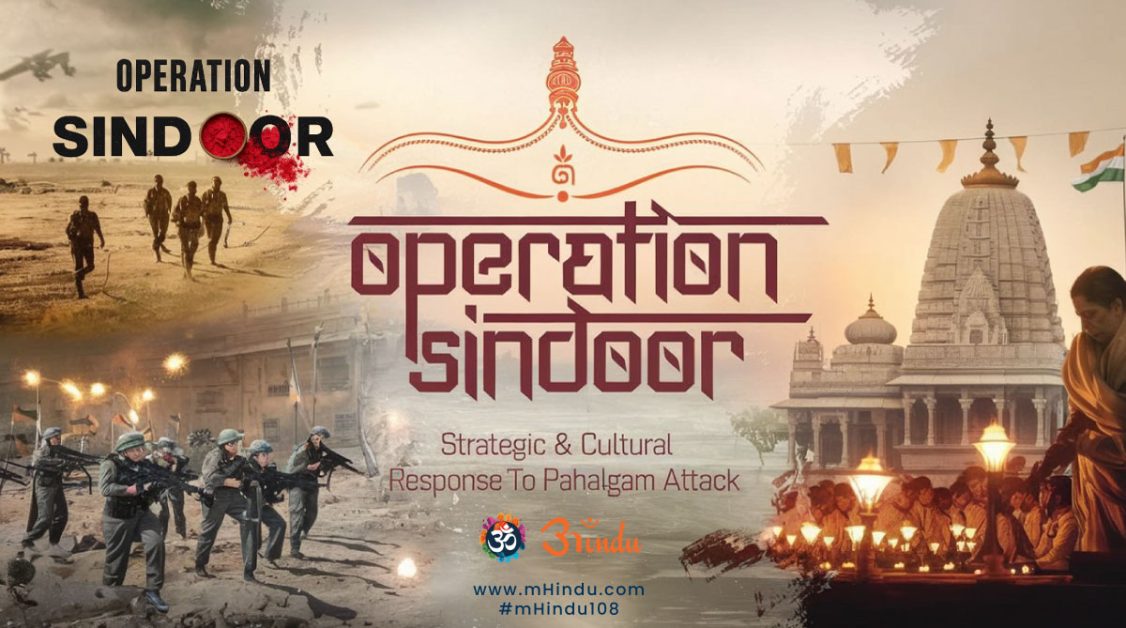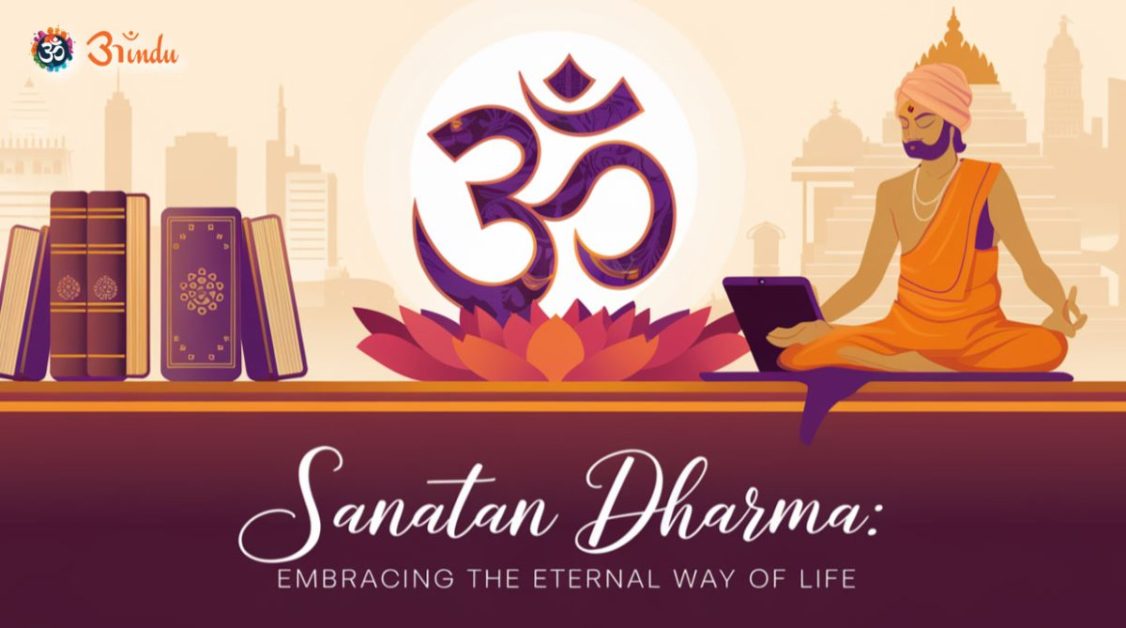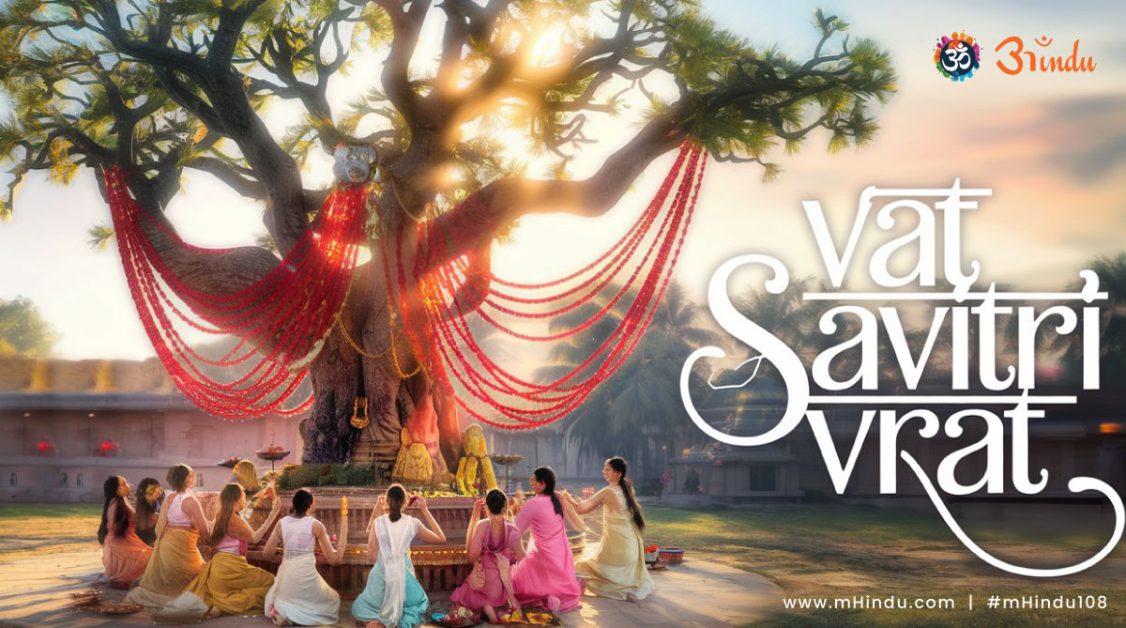
In the quiet of dawn, when the golden light begins to filter through temple bells and the fragrance of incense mingles with morning chants, a timeless ritual unfolds across Bharat. Married Hindu women, draped in vibrant sarees and adorned with mangalsutra, sindoor, and devotion in their eyes, gather around the sacred Vat (banyan) tree. They carry thalis of red threads, sweets, and flowers — not as a mere tradition, but as an act of deep love, commitment, and reverence. This is Vat Savitri Vrat, a sacred fast rooted in Sanatan Dharma and the legendary tale of Savitri, the woman who conquered death with her unwavering devotion and dharmic resolve.
Explore Blog Content
ToggleThe Primary Keyword “Vat Savitri Vrat” is not just a festival — it is a living legacy of the power of nari shakti (feminine strength) blessed by the divine. Celebrated mainly in the Indian states of Maharashtra, Uttar Pradesh, Bihar, Madhya Pradesh, and Odisha, Vat Savitri Vrat is observed on Amavasya (new moon) of the Jyeshtha month (May–June), aligning with the blossoming summer and the full shade of the banyan tree, symbolic of eternal life.
This vrat (fast) is a heartfelt prayer by married women for the well-being, longevity, and prosperity of their husbands. Inspired by the legendary Savitri, who through her wisdom and devotion, won back her husband Satyavan’s life from the clutches of Yama, the god of death — this vrat celebrates unshakable faith, satitva (chastity), and marital dharma.
Unlike many festivals that center around cosmic events or deities, Vat Savitri Vrat uniquely honors human dharma in divine light — a woman’s choice to uphold her vows even in the face of the greatest adversity. It’s this spiritual essence that gives the vrat its profound place in the heart of Hindu women and families across generations.
“धर्म एव हतो हन्ति धर्मो रक्षति रक्षितः”
“Dharma destroys those who destroy it; Dharma protects those who protect it.”
— Mahabharata, Anushasana Parva
This shloka beautifully aligns with the spirit of Savitri — whose adherence to dharma even when challenged by Yama himself, turned fate in her favor.
In this blog, we will journey through the deeper meanings of Vat Savitri Vrat, the timeless story of Savitri and Satyavan, the spiritual rituals and symbolism involved, and why this festival is still relevant in the modern Hindu world.
The Origin and the Legend of Vat Savitri Vrat
To understand the significance of Vat Savitri Vrat, we must begin at the roots — the story of Savitri and Satyavan — found in the ancient scripture Mahabharata, under the Vana Parva (Book of the Forest).
Savitri, the daughter of King Ashwapati of Madra Kingdom, was born after years of penance and prayers. The king had prayed fervently to Goddess Savitri, and when blessed with a daughter, named her accordingly. Savitri grew up to be not just extraordinarily beautiful but spiritually wise, intellectually sharp, and deeply dharmic. Her life’s turning point came when she chose Satyavan, the son of the exiled blind King Dyumatsena, as her husband.
Despite being warned by the sage Narada that Satyavan had only one year left to live, Savitri stood firm in her decision. Her clarity reflected the highest ideal of pativrata dharma — not as submission, but divine strength born of love, faith, and sankalpa (firm resolve).
As predicted, on the day of Jyeshtha Amavasya, while in the forest, Satyavan fell unconscious and passed away. Yama, the god of death, appeared to claim his soul. But Savitri followed him — barefoot, determined, and unyielding. Through her profound knowledge of dharma, she engaged Yama in spiritual dialogue.
Moved by her dedication, Yama offered her three boons — all of which she used selflessly, and finally, without directly asking for Satyavan’s life, cleverly ensured his return. Her intellect and compassion left Yama with no choice but to grant her wish, restoring Satyavan’s life and future.
This story is the foundation of Vat Savitri Vrat — representing how a woman, empowered by dharma, can alter destiny itself.
“नैव स्त्री स्वातन्त्र्यमर्हति”
“Woman is not bound by dependence, but by her own svadharma.”
— Manusmriti (adapted contextually)
What is the story behind Vat Savitri Vrat?
The vrat is inspired by the legendary tale of Savitri, a devoted wife who, by her steadfastness and cleverness, won her husband’s life back from Yama. The story illustrates devotion, moral strength, and the victory of dharma over death.
Who were Savitri and Satyavan in Hindu scriptures?
Savitri was a princess of Madra kingdom, known for her wisdom and virtue. Satyavan, her husband, was the exiled prince of a blind king. Their love story and Savitri’s confrontation with Yama is chronicled in the Mahabharata, forming the basis of this vrat.
Why Hindu Women Observe Vat Savitri Vrat
In the fabric of Sanatan Dharma, vrats are not mere customs — they are soul-stirrings of devotion, karmic alignments, and inner transformations. Vat Savitri Vrat stands out among these as a sacred day where a woman’s shraddha (faith) and sankalp (resolve) come together to invoke divine blessings for her husband’s well-being and her marital dharma.
Why do Hindu women, even today, leave aside their routines, adorn themselves in bridal finery, and fast in the peak of summer to pray under a banyan tree? The answer lies in cultural memory and spiritual resonance.
The Vat or bargad tree represents Trimurti — Brahma (roots), Vishnu (trunk), and Shiva (leaves), and is considered a kalpa vriksha — the wish-fulfilling divine tree. Just as the banyan tree spreads wide and strong, offering shelter and longevity, women symbolically align themselves with its strength and resilience by tying threads and performing parikrama.
“वटवृक्षं परिक्राम्य पतिं चिरंजीविनं कुरु”
“I circumambulate the sacred Vat tree; may my husband live long.”
— Vrat Katha verses
The fast is not just for longevity but also to align oneself with savitri tattva — the energy of determination and divine womanhood.
Women eat only after completing the puja, which involves offering soaked rice, flowers, red cloth, and tying the sacred thread around the tree. Prayers are offered to Savitri and Satyavan, and the story is recited — sometimes in groups, sometimes whispered with devotion.
What are the benefits of keeping Vat Savitri Vrat?
Spiritually, the vrat strengthens a woman’s connection with her dharma and invites divine blessings for her husband’s long life. It fosters mental strength, patience, and a higher sense of feminine identity rooted in shakti and sanskar.
Why do married women tie threads around a banyan tree?
Tying threads around the Vat tree represents the sacred bond of marriage and the circle of life. The banyan tree’s symbolism of eternal life mirrors the wish for an unbreakable bond between husband and wife.
Rituals and Puja Vidhi of Vat Savitri Vrat
As the first light of Jyeshtha Amavasya rises, preparations for Vat Savitri Vrat begin early. In many homes, especially in northern and western India, this day is marked by a unique sanctity — both festive and meditative. While modern lives have shifted to urban settings, the essence of the rituals remains deeply rooted in Vedic tradition and feminine devotion.
The puja vidhi of Vat Savitri Vrat is detailed in the Vratraj, Skanda Purana, and several regional scriptures. Women traditionally observe a nirjala vrat — a fast without even water — as a mark of discipline, echoing Savitri’s endurance. However, depending on individual capacity and family tradition, some keep a phalahar vrat — eating only fruits post-puja.
The Core Rituals Include:
- Snan and Sringar: Women bathe early, wear new or bridal clothes, apply sindoor, and adorn themselves with bangles, anklets, and mangalsutra — signifying marital bliss.
- Puja Thali: A beautifully decorated plate with soaked rice, sacred thread (kalawa), wet pulses, copper coins, red cloth, fruits, and sweets is prepared.
- Vat Tree Worship: The sacred banyan tree, often located in temple compounds or courtyards, is cleaned and sprinkled with ganga jal. Women perform parikrama (circumambulation) of the tree seven times, tying sacred threads around the trunk while chanting mantras.
- Story Recital: The Vat Savitri Vrat Katha, narrating the tale of Savitri and Satyavan, is read aloud or listened to from elders or priests.
- Dakshina and Charity: Gifts, clothes, and food are offered to married women (suhagans) and Brahmins, as blessings are believed to multiply when shared.
“सावित्री व्रतमेतत्तु ये स्त्रियो भव्यदर्शिनः।
भर्तुः प्रियं कुलस्यैव वर्धनं च भविष्यति॥”
“Women who observe the Savitri Vrat bring prosperity to their husband and uplift the entire family.”
— Vratraj, Chapter 12
In modern times, many women also perform the rituals at home, using a symbolic Vat tree made from sugarcane sticks or silver idols. Some join digital satsangs or temple livestreams — blending tradition with tech while preserving the sanctity of the vrat.
How to do Vat Savitri Vrat at home if there’s no banyan tree nearby?
Many women create a symbolic banyan tree using sugarcane sticks, peepal leaves, or even silver Vat tree idols. With devotion, chanting mantras, and reading the story, the vrat can be equally fruitful at home.
Can unmarried or pregnant women keep Vat Savitri Vrat?
Traditionally, it is a vrat for married women. However, some regional customs allow unmarried women to keep it with the intention of finding an ideal partner. Pregnant women may observe it with caution and consume light fruits as needed.
Spiritual Significance and Symbolism of the Banyan Tree
In the Sanatan Dharma worldview, trees are not mere botanical entities — they are sacred beings, embodying cosmic energies. The banyan tree, or Vat Vriksha, holds a special place as it symbolizes immortality, stability, and dharmic shelter.
It is said in the Bhagavata Purana that Lord Krishna identifies himself with the Ashvattha tree (peepal), and Lord Shiva is believed to reside in the banyan. The wide canopy of the banyan, its prop roots, and perennial life embody the ideal grihastha ashrama — the householder’s journey that nourishes many while staying grounded.
In Vat Savitri Vrat, the banyan tree becomes the silent witness to the sacred vows of women — their prayers whispered into the roots of time, their threads binding love and life.
“वटवृक्षो यथा स्थायी, न परिवर्तते यदा।
तथा मे जीवनं नाथं, चिरंजीवत्वमस्तु ते॥”
“As the banyan stands unshaken, may your life, my beloved, be as enduring and divine.”
The parikrama around the Vat tree symbolizes the circle of life, karma, and dharma, while the sacred thread tied around it mirrors the eternal bond between husband and wife — beyond this lifetime.
This ritual isn’t just about marital longevity. It’s about invoking the qualities of strength, patience, rootedness, and eternal shelter — traits every grihini aspires to embody.
Even in Ayurvedic traditions, the Vat tree is considered sacred for its healing properties. Its bark, leaves, and sap are used in various remedies, symbolizing that this tree nurtures the body and spirit alike.
Why is the banyan tree considered sacred in Hinduism?
It is believed to be the abode of the Trinity — Brahma, Vishnu, and Shiva. The tree’s eternal life and wide shelter make it a symbol of protection, fertility, and divine blessings in Sanatan Dharma.
Is there a scientific reason behind worshipping the Vat tree?
Yes. The banyan tree releases oxygen even at night and has extensive medicinal benefits. Its shade provides cooling, and it supports micro-ecosystems — echoing the nurturing energy it represents spiritually.
Vat Savitri Vrat in Modern Times — Relevance and Reconnection
In an era where life moves at 5G speed, traditions like Vat Savitri Vrat serve as soulful pauses — a moment for women to reconnect with their inner strength, their spiritual roots, and their roles in nurturing dharma.
Urbanization, nuclear families, and changing societal dynamics often distance us from such rituals. Yet, it is remarkable how women — from Gurgaon to Goa, from metros to mandirs — continue to uphold the legacy of Savitri with evolving methods.
Modern Hindu women are lawyers, teachers, tech leaders, and CEOs — but when it comes to Vat Savitri Vrat, they carry forward the same intention as their grandmothers: to protect love through dharma.
In some cities, temple communities organize Vat Poojas in parks or temple premises, inviting women to share stories, chant mantras, and perform the rituals together. WhatsApp groups send reminders of sunrise muhurats and puja vidhi videos. Instagram reels share stories of Savitri with creative animations. This is Sanatan Dharma adapting — never abandoning.
“सत्यं वद, धर्मं चर”
“Speak truth, follow dharma” — Taittiriya Upanishad
The essence of Vat Savitri Vrat is not just in ritual precision, but in intentional living — staying truthful to one’s path and cultivating inner strength, like Savitri.
Many younger women now observe it not out of compulsion but from a place of pride and purpose. They recognize that Savitri was not just a devoted wife, but a spiritual warrior, standing firm before the god of death itself.
How can working women keep Vat Savitri Vrat?
With early preparation and simplified rituals, the vrat can be observed before office hours or in the evening at home. What matters is the sankalpa (intention), not the grandeur.
Is Vat Savitri Vrat relevant for the younger generation?
Yes. It offers a deeper understanding of commitment, devotion, and feminine strength. In times of transient relationships, it becomes a symbolic anchor of timeless values and inner power.
Summary
Vat Savitri Vrat is not just a ritual — it is a soul offering from women to the divine through their marriage vows. Rooted in the legend of Savitri, the woman who stood up to Yama and won her husband’s life back with her wisdom, faith, and determination, this vrat is a living embodiment of shakti and dharma.
Each thread tied to the Vat tree is a silent prayer, each parikrama is a reaffirmation of the sacred bond of grihastha dharma. As women fast and pray, they not only seek blessings for their husband’s longevity but also align with the values that Savitri upheld — strength in adversity, love grounded in duty, and a fierce sense of righteousness.
From traditional banyan tree rituals in rural temples to Instagram-reel pujas in metropolitan homes, the festival has evolved — yet its aatmik bhav (spiritual essence) remains untouched. It reminds us that Sanatan Dharma isn’t about blind following — it’s about conscious living, meaningful rituals, and deep emotional connection to values.
Today, Vat Savitri Vrat speaks not only to the older generation but to every woman who seeks a sacred pause, a moment of connection to her roots, and a celebration of divine feminine strength. In a world growing distant from stillness, this vrat is an invitation to step into the shade of eternal truths, just like the Vat tree offers cool refuge under its vast canopy.
Let us preserve such festivals — not just as rituals of the past, but as living traditions of spiritual renewal, dharmic strength, and emotional grounding. In the echo of Savitri’s footsteps, each Hindu woman walks with pride, power, and divine light.
FAQs (Vat Savitri Vrat)
1. What is Vat Savitri Vrat and why is it observed?
Vat Savitri Vrat is a Hindu fast observed by married women for the long life and prosperity of their husbands. It honors the legendary devotion of Savitri who brought back her husband’s life from Yama through her wisdom and dharma.
2. When is Vat Savitri Vrat celebrated?
It is celebrated on the Amavasya (new moon) of the Jyeshtha month, usually in May or June, depending on the Hindu lunar calendar.
3. Is Vat Savitri Vrat only for married women?
Traditionally yes, but in some regions, unmarried women may observe it with the intention of receiving a good life partner, similar to Karva Chauth or Hartalika Teej.
4. Can Vat Savitri Vrat be done without a banyan tree?
Yes. A symbolic Vat tree made from sugarcane sticks or silver idols can be used. What matters most is the devotion and intent behind the ritual.
5. What food is eaten during Vat Savitri Vrat?
Women usually keep a strict fast without food or water (nirjala vrat). However, depending on health and tradition, some may consume fruits or light foods after completing the puja.
6. What does tying thread around the banyan tree signify?
It symbolizes the strength and longevity of marriage. The banyan tree represents eternal life, and the thread signifies the unbreakable marital bond.
7. What is the story of Savitri and Satyavan?
Savitri, a devoted wife, followed Yama (the god of death) when he took her husband’s soul. Through her knowledge of dharma and selfless love, she compelled Yama to return Satyavan’s life.
8. Why is Vat Savitri Vrat important in today’s time?
It reinforces timeless values — love, loyalty, spiritual strength — that remain deeply relevant. It connects women to their inner power and roots in Sanatan Dharma.


